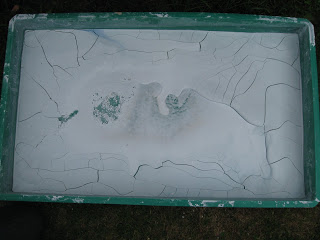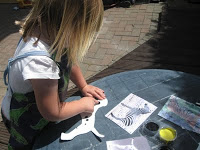As you can see from my previous blog, the children have been engaged in exploring gloop this week. However this activity then took a slightly different direction from normal and provided a fantastic example of child-initiated play and the evidence of children’s knowledge that can emerge when something really catches their interest.
I had also provided this activity at the Childminding Group and as I struggled to get the tray back into the garden, I caught the attention of the children. ‘What are you doing?’ they enquired. As I explained that it was just the gloop from the group, their next question was ‘Can we play with it?’ As I put the tray on the ground, the gloop that had dried out (I had been very lazy and left it in the car since we got back from the group the previous day), broke into lots of pieces, resembling a jigsaw puzzle.
I commented on this to the children, but it wasn’t the jigsaw puzzle aspect that caught their interest. They found that dried out gloop was very easy to break into smaller pieces and equally easy to crumble between your fingers.
Well this discovery had them totally hooked. Every piece has to be broken and crumbled! I did wonder whether it was the fact that they could break something without being told off that they found engaging! or whether this was just an experience they hadn’t come across before. Thinking about it, we had never done an activity that could be explored in this way.
What I particularly found amazing about this activity was the language that accompanied their play. In my less experienced years, noticing children engaged in an activity I hadn’t planned for, I would have been temped to run inside to get my EYFS, to see how I could direct their play to meet the developmental matters. However now being much more relaxed and having a better understanding of child initiated play, I was happy to go with the flow! And the children didn’t need any direction. They happily chatted about the shapes of the gloop as they broke pieces off. They used both mathematical terms such as ‘square and triangle’ and compared the triangles to pyramids.
As the gloop was gradually transformed into smaller and smaller pieces, the children described it as ‘cake mixture’ and ‘snow’. They tried to build with it, telling me they had made a ‘sandwich’ and a ‘sausage roll’.
This led to discussions about who might be living under the bridge (the troll) and who might need to go over the bridge (billy goats). The children also made up tunes as they played which described their actions. Well then they decided that they wanted to do it all again! I explained that we needed to add water and then we would have to leave it to dry out again and most importantly, they wouldn’t be able to play with it until tomorrow. They were happy to do this and helped to add the water.
Only we forgot to tell my six year old daughter when she came home from school, and she dug her hands straight into the gloop, much to the annoyance of the other children! A bit more water and it would be fine!
The children’s play and exploration has given me some ideas for futher uses of gloop in this form, for example in winter small world play with the bonus of melting snow by adding water!
















